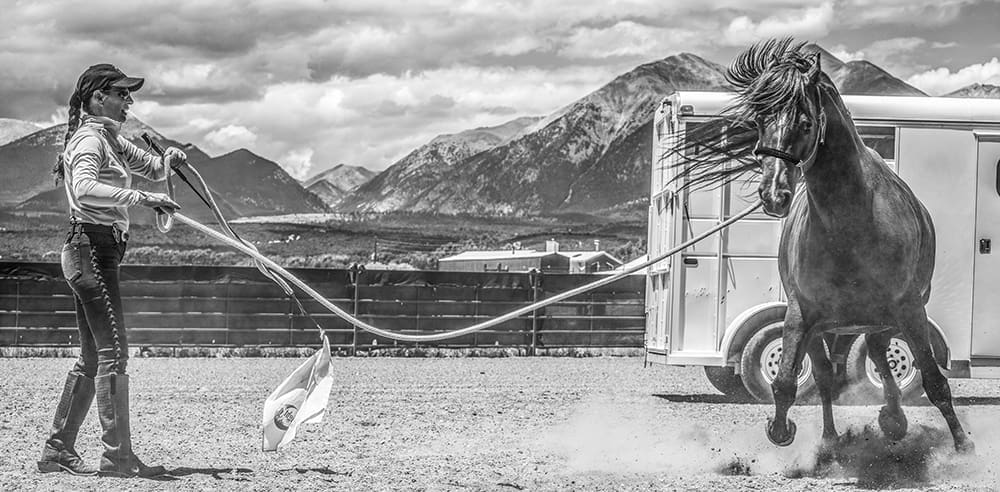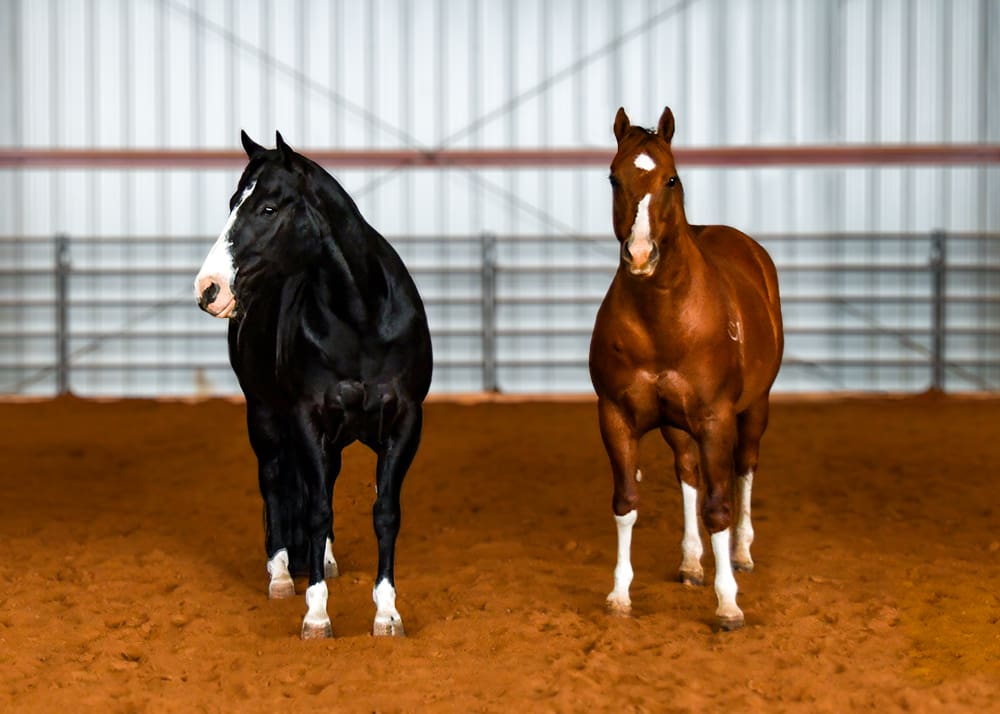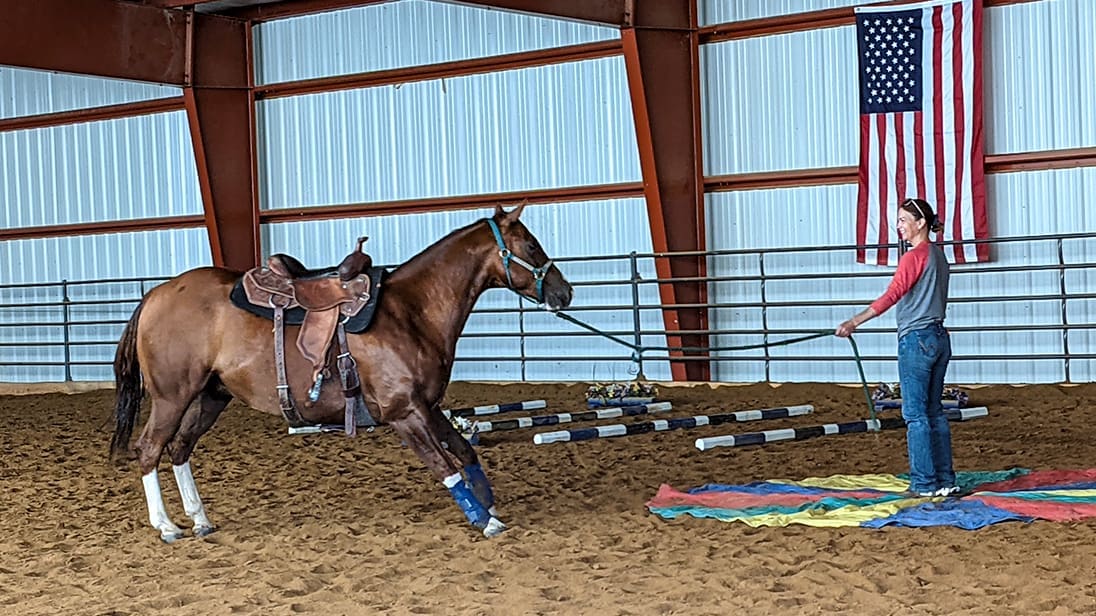
Whether your equestrian goals involve a competition, a trail adventure, or building the confidence to try something new, it’s likely that you will experience periods of anxiety and moments of doubt in your journey.
This sport is hard. It’s unreasonable to think everything will always go right, and you’ll never make a mistake. As Mark Twain said, “Good judgment comes from experience, and a whole lot of that comes from poor judgment.” Make peace with the fact that there will be good days and not-so-good days, some things will go right, and other things won’t—and that’s okay! It all contributes to your portfolio of experience.
What’s Your Plan?
In the hard moments—no matter what your equestrian endeavor—it’s good to have a plan, a specific focus, or a mantra in your back pocket for when you need it.
“Eyes–breathe–sit back.”
“Slow down and breathe.”
“Stop–back–turn.”
“Eyes–rise–thighs.”
“Whoa–sit–reins.”
Horses are even more emotional than humans, and they instinctively adopt the emotions of the animals around them—it’s a survival response. That is why it’s important to have a strategy to keep your emotions in check and keep your anxiety from getting the better of you, so you can be the leader your horse needs.
No matter what you’re doing with your horse, you’ll find that having these tools will help you build the mental discipline and mental toughness that give you a leg up in this sport.

*Free shipping to U.S. addresses only, shipping will be adjusted on international orders.
Manage Day-Of Anxiety
Whatever type of riding I am doing, if it’s important or difficult, I like to stay very close to my horse all day—physically, and mentally. I like to be alone with her before my ride—no other horses or people around us. It helps both of us stay focused and calm.
I like to keep my mind uncluttered, focused only on the ride. Sometimes I listen to tunes with my earbuds, since music relaxes me and helps me focus.
Other riders may prefer the presence of calm and supportive friends or a coach as they prepare for their ride. For some, distractions can prevent a build-up of nerves. If that’s the case for you, pick your company wisely. Seek people that are positive, keep you calm, build your confidence, and make you laugh.
As I warm up my horse on a loose rein, an internal video of my ideal ride—every stride, every marker, every maneuver—is playing in my head. Visualization is essential for me to ride my best, and horses tend to respond better when you picture your ride.
I do not drill or school my horse the day-of. At this point, it’s too late for training—it’s go time. I want my horse to stay either focused on me or focused on “nothing” (relaxed). What’s most important to me at this time is the connectivity with my horse—the mind-meld that occurs when we are tuned in to each other, riding with synchronicity and a common purpose, with both our heads in the game.
It’s unreasonable to think you’ll never feel fear or anxiety, especially when you are venturing into new territory with your horse. So focus on what you can control before you succumb to the paralysis fear can cause. Remember the antidote to fear– eyes, breathing, body language. Keep your eyes focused on the environment around you, use deep abdominal breathing, and adopt a confident posture (look up ‘power poses’). Never let your anxiety creep into your body language and posture.
Mental Discipline and Awareness
You have control over the thoughts in your head, and you can choose to think positive and productive thoughts. Don’t fall victim to mind pollution, and let the thoughts of “what if” scenarios or “my horse is going to spook” creep in. If you do, it’ll creep all the way to your horse.
Presume everything will go well, presume your horse will respond as he is trained to do. But stay tuned in to your horse, and ride the horse that’s underneath you at that moment.
Along with your positive thoughts, you also have complete control of your posture, your body language, your position in the saddle, where you look, and your rate of breathing. I like to breathe in rhythm to my horse’s stride. It keeps me relaxed and moving with my horse, and it brings a certain synchronicity with the horse.
From there, I can detect slight changes in my horse and adjust my aids sooner. I also use changes in my breathing to cue the horse. When you breathe in rhythm, the horse feels it. So when that rhythm changes, it becomes a signal. Horses tend to mimic breathing, so when the rider is breathing deep, steady breaths, it is good for the horse too.
Tune out distractions at the in-gate, or the start of your ride—fellow competitors (whether they are chatty or catty), even the announcer (they can be silly, or distracting). Listen to the person running the gate/the judges/ring stewards–whoever is in charge of letting you know when to start, and filter out all the other noise.
Trust Your Skills & Trust Your Horse
You’ve been working on this for months, trust that you can use the skills you have developed when you need them! Quit micromanaging and trust your horse to do his job, assuming he will do it perfectly (especially when it’s something he knows how to do).
In general, horses will act in the way you think they will, and do what you are thinking about. That’s why it’s so important to think positively and visualize your ride. Don’t try to prevent your horse from making a mistake, just correct and clarify when he does.
If you ride without trust and faith in your horse, he will feel that and learn not to try. A horse learns by making mistakes and getting corrected—just as do you. When you trust your horse, you can give him the freedom to do his job without interference or micromanagement. You may be surprised at what your horse will do for you when you trust him!

*Free shipping to U.S. addresses only, shipping will be adjusted on international orders.
Have a Back-Up Plan
Of course, things won’t always be perfect. Both you and your horse will make mistakes. Your horse is a living, breathing, emotional, pain-feeling animal, capable of independent thought and with a will of his own. There will always be ups and downs with horses, and it’s how you handle the hardship that can make or break you as an equestrian.
Have a plan for if things go awry, but ride your horse with authority and certainty that he will do it right. When things go wrong, and at some point they will, have a simple plan of action that will help you reconnect with your horse and reboot the system. Many riders succumb to paralysis when something goes wrong, shutting down rather than riding the horse in the way it is accustomed. Don’t be the rider that pulls back, clenches the reins, and tries to stop the ride and get off.
When something scary happens on your ride, divert your horse’s attention to another activity rather than focus on the scary thing. Don’t freeze—shift gears and do something else. Ride proactively with changes of direction and speed, so that your horse gets back in the groove of responding to your cues. This helps you start to think again, too, instead of focusing on the scary thing that just happened.
Always have a calm-down exercise to do with your horse when he needs it—a sequence of easy maneuvers, a plan B for your ride, or an alternative route. With a specific plan to pivot to if your horse gets anxious, you’ll feel more prepared to help him (and his temporary “moment” won’t make you both spiral).
Whatever the reason for the disruption, when a horse I am riding becomes volatile, I will ride it forward, turning right then left then right, bending the horse’s neck softly from side to side, changing speeds, and redirecting the horse one way, then another. Going back to basics (go-turn-stop), issuing cues, and riding the horse in a familiar manner usually brings the horse back to a responsive and thinking frame of mind promptly.
When something goes wrong, riding forward is generally better than stopping since forward motion is the basis of all training, and riding horses is about controlling forward motion. Horses are flight animals, so they typically respond better when they are moving than when forward motion is inhibited. It’s almost always easier to control the forward motion of the horse, than it is to stop and try to contain it.
Be a proactive rider in times of stress. Riding proactively means being decisive and structured in what you ask of your horse. Look around, find a destination and ride there. Ask the horse to move forward, then make some turns and changes of direction to establish more control. The more changes of directions and changes of speed you make, the more responsive your horse will become.
After it’s Over: Debrief
If it goes well… great! What’s the next step? How do you improve? Do you and your horse need more training or just maintenance? Are you ready to step up to the next level? What will it take to get you there? It’s important to recognize what you and your horse did well. These are your strengths, and you should always recognize your strengths and build on them.
If things didn’t go perfectly, or quite the way you envisioned, it’s critical to dissect the ride, evaluate its components, and focus on where you could improve. Let yourself off the hook, don’t beat yourself up, or worse, blame your horse or blame someone else. It’s behind you now and the only reason to replay it, is to find the errors and develop a plan to refine your skills.
Even if your ride went awry, pick out at least one thing that you and your horse did well, and let yourself be happy and proud of that moment. Riding sports are complicated. You probably won’t get everything right the first time out of the box, but with each new experience, you’ll build skills and knowledge that will keep you improving.
However you and your horse performed, plan to build from there next time. You now have a new baseline expectation. Looking back at the whole endeavor, think about how you want to move forward. It may be time to revisit your goal worksheet to help you refine your goals and/or come up with new ones.

*Free shipping to U.S. addresses only, shipping will be adjusted on international orders.



